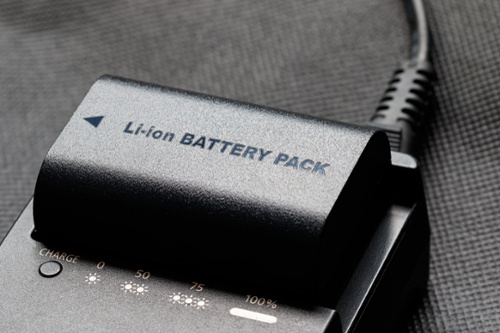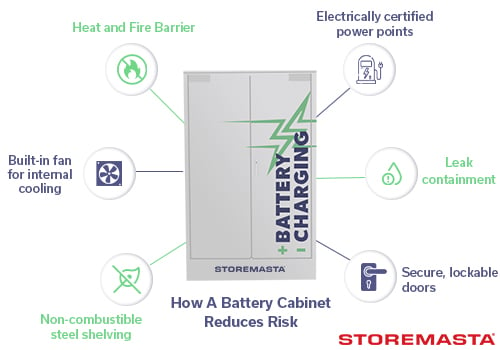When you think of Dangerous Goods, you probably don’t think about the batteries you use to power your daily operations. But even simple items such as the battery in your phone or the power source for your industrial robot are products which require careful consideration if they’re being handled, stored and recharged. Some batteries are recognised as being Class 9 Dangerous Goods, but there is not always a lot of information available about the best way to look after your workplace batteries. In this blog, we’ll be looking at the different types of batteries that you may find in your organisation and the hazards that they may pose. We’ll also be detailing some tips on the safest way to store batteries, so you can effectively reduce your risks.
Types Of Batteries Commonly Found In Workplaces
There are a variety of different types of batteries found in businesses, whether you’re running a mining site, a manufacturing firm or a mechanical workshop. From tools to devices and equipment, batteries are an affordable and reliable power source that are found in a diverse range of businesses.
![]()
Batteries are an essential energy source for almost every type of business, powering equipment such as forklifts, power tools and electric vehicles.
The most common types of batteries include:
- Alkaline batteries
- Lead acid batteries
- Nickel-based batteries
- Lithium-ion batteries
Alkaline Battery Storage
Made from zinc and manganese dioxide electrodes with potassium hydroxide electrolyte, this type of disposable battery is popular for use in everyday items such as remote controls and small appliances. These batteries are available in a range of sizes, including AA and AAA, and offer a good shelf life (for a disposable battery) as well as high energy density.
However, as most of us have experienced, alkaline batteries are known for leaking – which can cause harm to the device or equipment in which it’s installed. Leaked battery acid (potassium hydroxide) can also result in skin burns if the chemical is not washed off the skin immediately. The good news is though, that this battery leak is one of the easiest to neutralise and clean up. Simply wash the skin as soon as possible with cold water for 30 minutes. You should also make sure that all damaged equipment and batteries are no longer in use.
To reduce the problems with leaking batteries, it’s important to monitor your batteries and discard old, damaged or leaking products. You should also ensure that the storage area where you’re keeping your alkaline batteries is not prone to high temperatures or humidity. Keeping your batteries in the original packaging or a sealed container can also assist with the prevention of damage and acid leaks.
Storing Lead Acid Batteries
Lead acid batteries are rechargeable products with low energy density. They are often found in vehicles, marine craft, alarm systems, emergency lighting and electric wheelchairs.
The battery is made with a lead negative electrode and a lead oxide positive electrode – both of which are submerged in sulfuric acid and water. Some key issues with lead acid batteries can include sulfuric acid leaks and the potential for explosion (when the battery is charging). To mitigate these hazards, PPE is appropriate for staff who are working with lead acid batteries. When storing and charging these products, it’s important that the space you choose has adequate ventilation and is free from ignition sources.
![]()
Choose a well-ventilated space that’s free of ignition sources to charge your lead acid batteries to reduce the likelihood of an explosion.
Gassing of the battery is when oxygen and hydrogen gas evolve and reduce water from the electrolyte. If this gas meets an ignition source in the workplace, an explosion can occur. Therefore, keeping batteries in a well-ventilate area away from ignition sources can reduce the risk of ignition.
If a lead acid battery spill or leak does occur, great care must be taken to remove this corrosive substance. This type of battery acid can produce skin, eye and respiratory problems, so you should wash the acid off with a mixture of warm, soapy water to eliminate the harmful acid from the body.
Choosing drip trays or bunded storage for your lead acid batteries is a simple solution that can help contain and manage any battery acid spills.
REMEMBER: You must always ensure that your batteries (and any other hazardous chemical products) are disposed of in a safe and compliant way. Check with your local waste disposal authority to learn more about the disposal or recycling options that may be available in your region.
Safe Storage Of Nickel-Metal-Hydride (NiMH) Batteries
NiMH batteries are rechargeable batteries which are known for their higher energy density. While this type of battery can be used as a substitute for alkaline batteries, they are less likely to product battery acid leaks.
As a nickel-based battery, their technology was developed over a period of decades with the first NiMH battery reaching the market in the late 1980s. These batteries are often used in hybrid vehicles and digital cameras.
This type of battery has few risks and is made with non-toxic electrode materials. They aren’t prone to rupturing and less likely to explode. However, these batteries will get flat if they’re not regularly recharged and used.
NiMH batteries can be recycled and are regarded as an environmentally-friendly battery. While users should be careful not to overcharge these batteries as they are sensitive to overcharging, they are an easy battery to store. Select a storage location that’s within normal working temperatures (not in excess of 45°C) with low humidity levels. If you are storing your batteries for a longer period, store them between the temperature range of 10 – 30°C to avoid self-discharging.
![]()
NiMH batteries are best stored in non-humid locations that aren’t subject to extreme cold or heat.
These batteries work best when they are regularly charged and discharged, so don’t leave your batteries idle for long periods of time.
How To Store Lithium-Ion (Li-ion) Batteries
While some of the previously mentioned batteries don’t require specific control measures to ensure safety, care should be taken when you’re storing and charging Li-ion batteries.

Li-ion batteries must be stored and charged to reduce the risk of fire and explosion.
Li-ion batteries are Class 9 Miscellaneous Dangerous Goods and present hazards to the organisations who use or transport them. As a battery that has become increasingly popular with technological applications, Li-ion batteries power a range of devices and equipment across a broad range of industries. Whether it’s power tools, phones, laptops or medical devices, Li-ion batteries are an ever-growing presence in workplaces who are looking for a rechargeable battery with high energy density.
But how can the charging and storage of Li-ion batteries create a hazard for workplaces? In simple terms, when the battery is discharging, the negative electrode moves through the electrolyte to the positive electrode. The process is reversed when the battery is charging. During the recharging process, the battery can react and behave in ways which create a fire or explosion hazard.
If the battery does malfunction, thermal runaway will occur — which can set off a chain of events that adversely affects all batteries that are kept close by. This only increases the fire and explosion risk, as more batteries succumb to thermal runaway.
Li-ion batteries must therefore be handled, stored and recharged in such a way as to reduce this risk.

IMPORTANT: How you care for your batteries can not only increase their lifespan but also reduce your risk. Damaged, old, overheated or overcharged batteries can contribute to an increased risk of fire and explosion in the workplace. Make sure you regularly inspect your battery supplies and safely discard batteries which are aged or damaged.
In addition to these risks, Li-ion batteries can also leak battery acid, although this is not as frequent an occurrence as with other types of batteries. Keeping your stores in a dry, cool environment will assist in keeping your batteries in good working condition.
There are many things that you can do to improve safety when storing and charging Li-ion batteries. These include:
- Using a charger that meets the national safety regulations
- Monitoring battery charge to avoid overcharging
- Never charging a phone on a soft surface that can trap heat
- Discarding old or damaged batteries safely
- Charging batteries in a safety cabinet with fire suppression
- Keep batteries in a store with spill containment
- Marking your store with the relevant DG signage and lithium-ion battery safety sign
Tips For Safe Battery Storage
Thanks for reading our blog about the safest ways to store batteries at your workplace. While there are many different types of batteries on the market, the increased prevalence of Li-ion batteries has heightened the need for safer storage options. One of the most popular and effective ways to prevent lithium-ion batteries fires, explosions and thermal runaway, is to store and charge your batteries in a dedicated battery cabinet.
If you’d like to learn more about reducing risk in your workplace, we have an eBook that can make the whole process a lot easier. Our Guide to the Safe Charging and Storage of Lithium-ion Batteries is a helpful resource for organisations that carry any quantity of Class 9 lithium-ion batteries. Our eBook details the importance of correct handling and storage procedures, as well as the maintenance and review of your controls. Why not grab your free copy of our guide today by simply clicking on the image below?

Living life by the 4 C’s of marketing – communication, coffee, compliance… and more coffee – Leisa Andersen is Storemasta’s Content Marketing Manager. When she’s not writing, you’ll find her enjoying all the good things in life, including shopping, travel and gluten free donuts.
